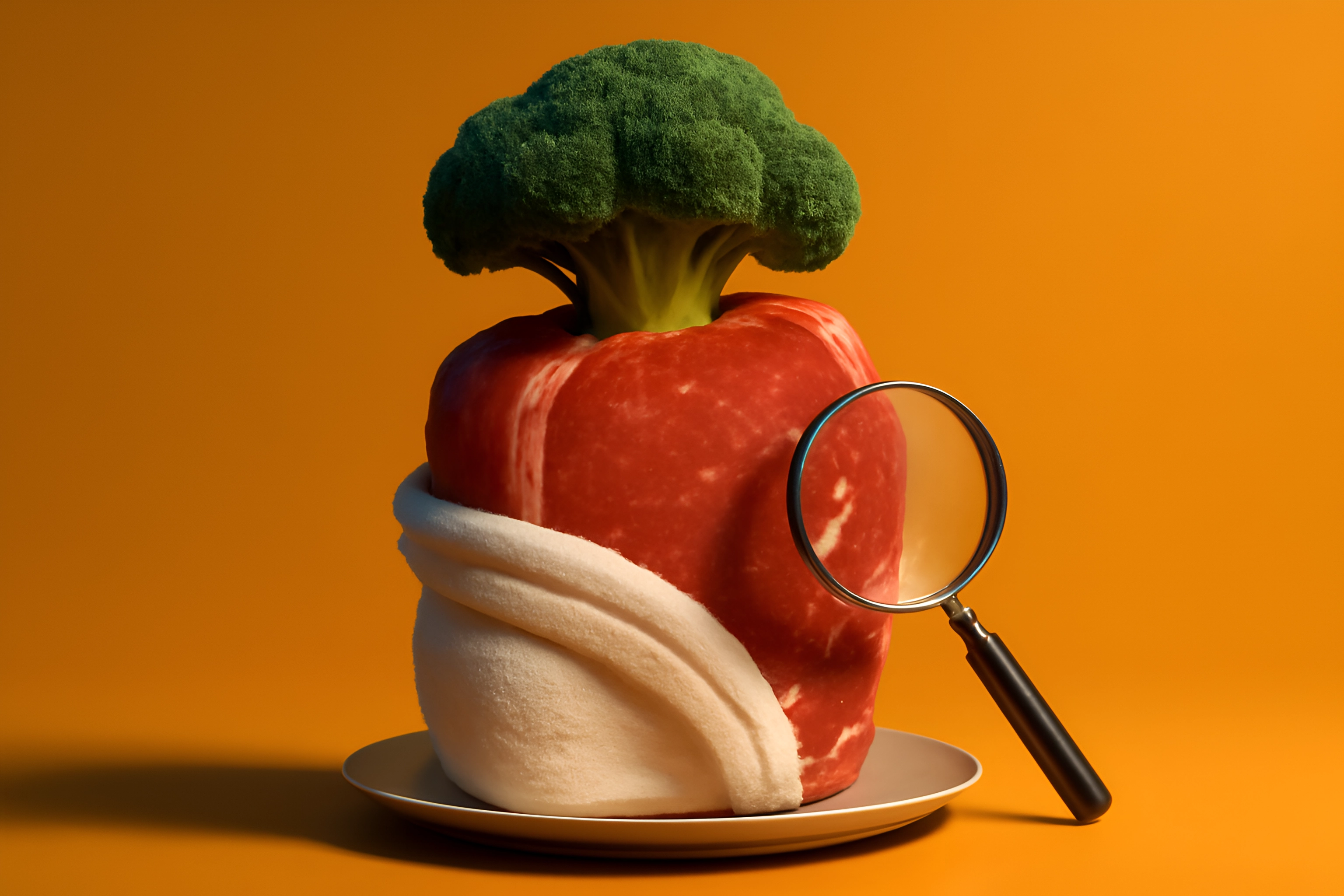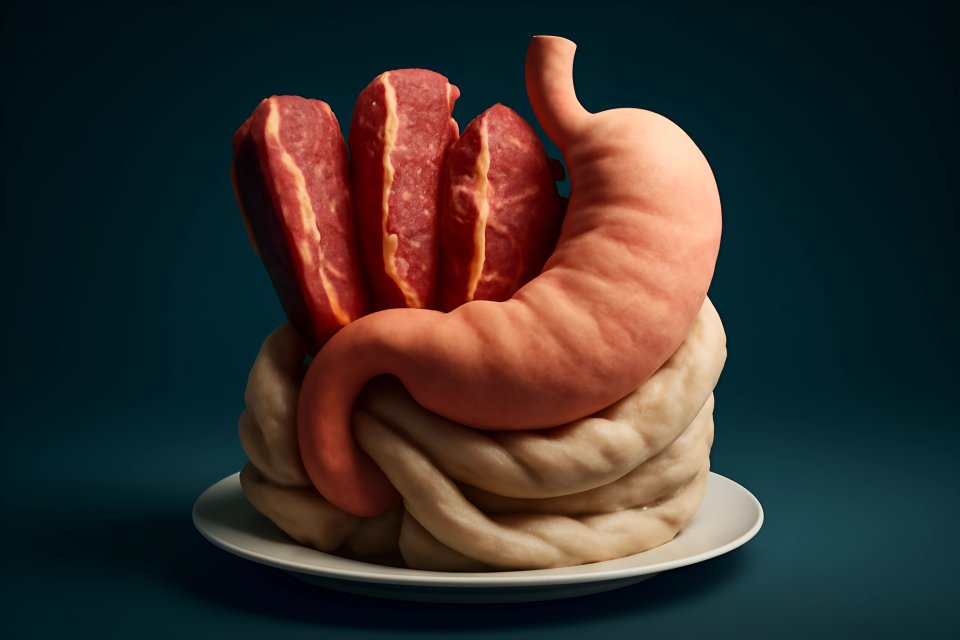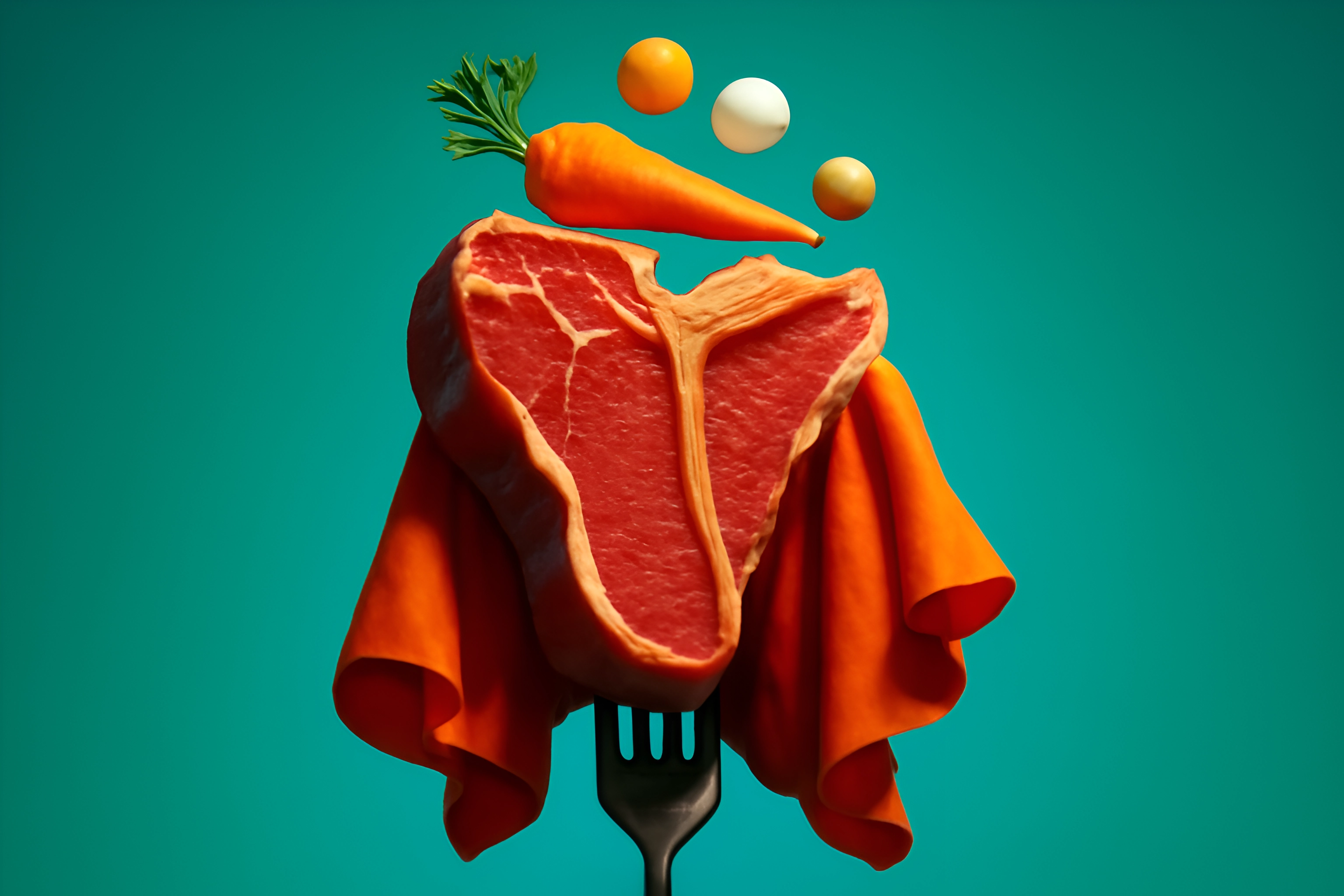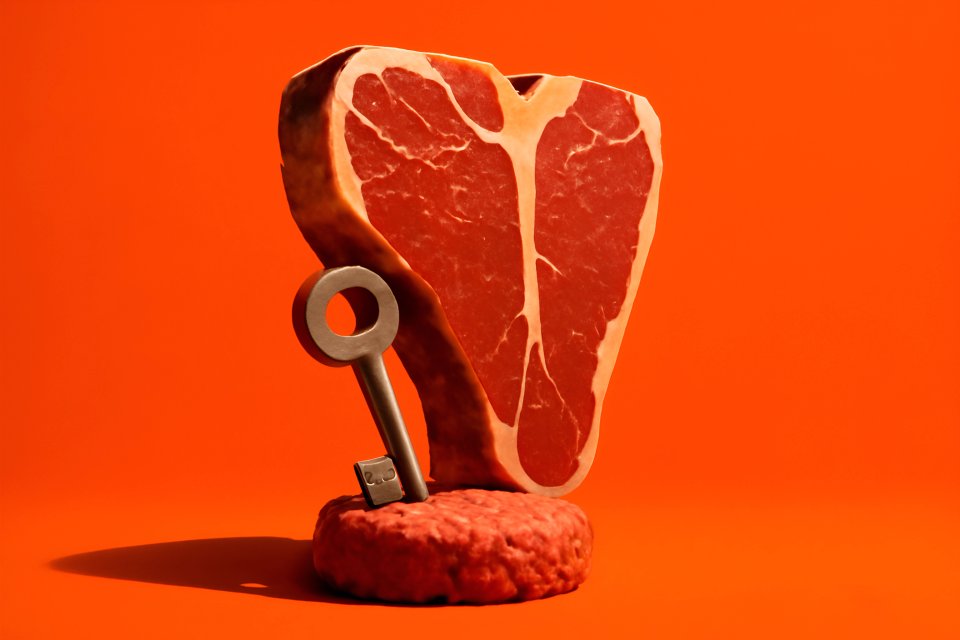
You've done the hard work. You've removed the plants, simplified your diet, and committed to the carnivore way of life. But you're still looking for that next level of gut healing, that final piece of the puzzle. What's the missing link between feeling good and feeling invincible?
The answer is simpler and more ancient than you might think. It’s not a new supplement or a complicated biohack. It’s bone broth, but not just any broth—it’s a foundational healing tool, a carnivore’s secret weapon for deep, lasting gut repair.
This isn't just another recipe post. We're going to break down the undeniable science behind why bone broth is a gut-healing powerhouse. You'll get simple, carnivore-approved recipes and learn exactly how to integrate this liquid gold into your daily routine for maximum, life-changing benefits.
Why Bone Broth is the Carnivore's Secret Weapon for Gut Repair
Think of it this way: muscle meat and fat provide the powerful, nutrient-dense building blocks for your body. They are the foundation of your strength and energy. But bone broth provides the specific, easily-absorbed nutrients that act like a specialized repair crew for your digestive tract, sealing and soothing the gut lining in a way that meat alone cannot.
The Science of a Healthy Gut Lining
For years, you may have suffered from what is often called "leaky gut," or intestinal permeability. This is a condition where the protective barrier of your intestines becomes compromised, allowing undigested food particles and toxins to enter your bloodstream, triggering inflammation and chaos throughout your body. While the carnivore diet removes many of the initial irritants, the pre-existing damage needs targeted support to fully heal. This is where the magic of bone broth comes into play, delivering a payload of specific amino acids that are critical for rebuilding the gut wall.
The true stars of bone broth are collagen and gelatin, which are packed with the amino acids glycine and proline. These compounds are the literal mortar needed to repair the bricks of your intestinal wall. Furthermore, bone broth is rich in glutamine, an amino acid that serves as the primary fuel source for the cells in your gut. In fact, clinical trials have shown that glutamine supplementation can normalize intestinal permeability in a staggering 79.6% of patients with post-infectious IBS.
Beyond the amino acids, a slow-simmered broth is a treasure trove of easily digestible minerals like calcium, magnesium, and phosphorus. These electrolytes are crucial for proper hydration and cellular function, especially when you're adapting to the carnivore diet or incorporating fasting. It’s a complete package designed by nature for deep, cellular-level repair.
Beyond the Gut: Total Body Benefits on Carnivore
The profound benefits of bone broth don't stop at your gut. The same collagen that heals your intestinal lining works wonders throughout your entire body, reinforcing the very framework of your health and vitality. Are you looking to improve your physical resilience? The glycine and proline in bone broth are essential for building strong joints, tendons, and ligaments, making it a key tool for superior athletic recovery and injury prevention.
This healing elixir also translates to visible results you can see in the mirror. The collagen provides the building blocks for smooth, hydrated skin and strong, healthy hair and nails, fighting the aging process from the inside out. Many people also report a surprising and welcome side effect: deeper, more restorative sleep. This is thanks to glycine, which has been shown to improve sleep quality and reduce daytime sleepiness.
Ultimately, by healing the gut, you reduce the systemic inflammation that is often the root cause of so many chronic health issues. This makes bone broth a cornerstone of not just a diet, but a comprehensive strategy for long-term wellness, perfectly complementing our other recipes designed for inflammation reduction.
The Problem with Store-Bought Broth
In a world of convenience, it’s tempting to grab a carton of bone broth off the grocery store shelf. But buyer beware. The vast majority of commercial broths are a pale imitation of the real thing, often doing more harm than good on a healing protocol. These products are frequently loaded with hidden plant-based ingredients, from vegetable powders and extracts to inflammatory seed oils.
Even worse, many contain monosodium glutamate (MSG) disguised under innocent-sounding names like "natural flavors" or "yeast extract." A recent Consumer Reports investigation found that many top-selling brands were little more than glorified soup stocks, lacking the protein and collagen density of a true bone broth. The quality of the bones is also a major concern, as conventionally-raised animals can accumulate heavy metals in their bones, which can then leach into the broth.
The solution is simple: make it yourself. Taking control of your broth-making process is the only way to guarantee its purity, potency, and healing power. It’s not only far more effective but also dramatically more cost-effective, ensuring you get a truly medicinal food that aligns with the principles of the HealingCarnivore lifestyle.
The Ultimate Guide to Making Carnivore Bone Broth
Forget complicated recipes and intimidating techniques. This is your definitive, no-fuss guide to creating liquid gold in your own kitchen. We'll walk you through every simple step, from choosing the right bones to the final simmer.
Step 1: Choosing the Right Bones (The Foundation of Quality)
The quality of your bone broth begins and ends with the quality of your bones. Different bones offer different benefits, so a good mix is often best. For a rich, gelatinous beef broth, prioritize marrow, knuckle, and neck bones. Oxtail is another fantastic addition that imparts an incredibly deep, savory flavor.
When it comes to poultry, chicken feet are the undisputed champions of collagen. They may look strange, but they are nutritional gold, containing up to 40% more collagen than other parts. Chicken necks and backs are also excellent choices that are often inexpensive and easy to find.
Most importantly, sourcing is key. Always prioritize bones from grass-fed, pasture-raised, and organic animals. This isn't just about ethics; it's about your health. Research has shown that bones from grass-fed cattle can have a 70% lower lead concentration compared to their conventionally-raised counterparts, ensuring your healing broth is as pure as possible.
Step 2: The Carnivore-Approved "Ingredients"
True carnivore bone broth is a testament to beautiful simplicity. You don't need a long list of vegetables or herbs to make a potent, flavorful broth. All you need are a few high-quality ingredients.
Here is your complete list:
- Bones: A mix of high-quality, grass-fed or pasture-raised bones.
- Filtered Water: Start with the best quality water you can to avoid adding unwanted chemicals like chlorine.
- Apple Cider Vinegar (Optional): A small splash (about 1-2 tablespoons per gallon of water) can help draw more minerals out of the bones. This is generally very well-tolerated and the amount is negligible.
- High-Quality Salt: Use an unrefined mineral salt, like Redmond Real Salt. Crucially, add the salt after the broth is finished cooking, as the liquid will reduce and can become overly salty if you add it at the beginning.
That's it. This simple combination is all you need to create a broth that is perfectly aligned with a strict carnivore diet for gut healing.
Step 3: The Cooking Process (3 Ways)
The secret to a great bone broth is a low, slow simmer. This gentle heat coaxes the collagen, minerals, and other nutrients out of the bones without destroying them. Here are the three best methods for making it at home.
| Method | Cook Time | Pros | Cons |
|---|---|---|---|
| Slow Cooker | 24-48 hours | Set it and forget it; very safe | Longest cook time |
| Pressure Cooker | 2-4 hours | Extremely fast; great extraction | Can reduce gel strength slightly |
| Stovetop | 12-24+ hours | Traditional; excellent flavor | Requires more supervision |
Method 1: The Slow Cooker (Set it and forget it)
Place your bones in the slow cooker and add the optional apple cider vinegar. Fill with filtered water until the bones are covered by about two inches. Set it on low and let it simmer for at least 24 hours for chicken and up to 48 hours for beef. Once done, strain the broth through a fine-mesh sieve and store it in glass jars in the refrigerator.
Method 2: The Pressure Cooker / Instant Pot (For fast results)
This is the perfect method for those short on time. Place your bones and optional vinegar in the pressure cooker pot and add water up to the max fill line. Secure the lid, set the valve to sealing, and cook on high pressure for 2-3 hours for chicken or 3-4 hours for beef. Allow the pressure to release naturally, then strain and store as you would with the slow cooker method.
Method 3: The Stovetop (The traditional way)
Place your bones and optional vinegar in a large stockpot and cover with filtered water. Bring to a boil, then immediately reduce the heat to the lowest possible setting where you can still see a gentle simmer—just a few bubbles breaking the surface. Skim any foam that rises to the top during the first hour. Let it simmer for at least 12 hours for chicken and 24 hours or more for beef. Strain and store.
Our Top 2 Carnivore-Friendly Bone Broth Recipes
Ready to get started? Here are our two go-to recipes that are simple, potent, and perfect for anyone on a healing journey.
Recipe 1: Rich & Hearty Beef Bone Broth
This is the ultimate healing broth, perfect for sipping on its own or using as a deeply nourishing base for ground beef or carnivore stews. Its rich flavor is pure comfort and medicine in a mug.
Ingredients:
- 3-4 lbs grass-fed beef bones (a mix of marrow, knuckle, and neck bones is ideal)
- Filtered water to cover (approx. 1 gallon)
- 2 tbsp apple cider vinegar (optional)
- High-quality mineral salt to taste (add after cooking)
Instructions:
- Pro-Tip: For a deeper, richer flavor, roast the bones on a baking sheet at 450°F (230°C) for 30 minutes before adding them to your pot.
- Place the roasted bones in your slow cooker, pressure cooker, or stockpot. Add the optional apple cider vinegar.
- Cover the bones with filtered water by about two inches.
- Cook using your preferred method: 24-48 hours in a slow cooker, 3-4 hours in a pressure cooker, or 24+ hours on the stovetop.
- Once cooking is complete, carefully strain the broth through a fine-mesh sieve into a large bowl or pot. Discard the bones.
- Allow the broth to cool, then transfer it to glass jars for storage. Add salt to your individual mug before drinking.
Recipe 2: Light & Golden Chicken Foot Broth
Don't be intimidated by the key ingredient! Chicken feet produce an incredibly collagen-rich broth that gels up beautifully when chilled—the true sign of a high-quality broth. It has a lighter, more delicate flavor than beef broth.
Ingredients:
- 2 lbs pasture-raised chicken feet
- Filtered water to cover (approx. 3 quarts)
- 1 tbsp apple cider vinegar (optional)
- High-quality mineral salt to taste (add after cooking)
Instructions:
- Pro-Tip: To ensure a crystal-clear broth, blanch the chicken feet first. Place them in boiling water for 5 minutes, then drain and rinse with cold water before proceeding.
- Place the blanched chicken feet and optional vinegar into your pot of choice.
- Cover with filtered water.
- Cook using your preferred method: 12-24 hours in a slow cooker, 2-3 hours in a pressure cooker, or 12+ hours on the stovetop.
- Carefully strain the broth through a fine-mesh sieve or cheesecloth for an even cleaner result.
- Let it cool and transfer to glass jars. You'll be amazed at the beautiful, firm gel that forms in the fridge.
How to Use Bone Broth for Maximum Gut Healing
Making the broth is the first step; integrating it effectively is where the real healing happens. Here are four powerful ways to make bone broth a central part of your carnivore protocol.
The Morning Ritual
Start your day with a warm, comforting mug of salted bone broth. Instead of the acidic jolt of coffee, you'll be bathing your gut lining in soothing collagen and providing your body with crucial electrolytes. This simple swap sets a foundation of healing for the entire day, providing gentle, easily-absorbed nutrition on an empty stomach.
During an Elimination Protocol
When you're on a strict carnivore or "lion diet" phase, bone broth is an indispensable tool. It provides a source of gentle nutrition that requires very little digestive effort, giving your system a much-needed rest while still delivering the building blocks for repair. It can help you navigate the adaptation phase with more energy and fewer cravings, making it a key component of our complete gut-healing carnivore recipes.
For Intermittent Fasting
Bone broth is the perfect companion for intermittent or extended fasting. A cup of broth can provide a feeling of satiety and a boost of electrolytes that helps curb hunger and maintain energy levels, all without significantly impacting your fasted state. It makes fasting feel easier and more sustainable, allowing you to unlock the deep cellular cleanup and metabolic benefits detailed in our guide to extended fasting on carnivore.
As a Cooking Liquid
Don't just drink your broth—cook with it! Use it to rehydrate ground beef, creating a juicy and incredibly nutrient-dense meal. Braise tougher cuts of meat like chuck roast or shanks in bone broth until they are fall-apart tender. Every time you use bone broth in place of water, you are infusing your meals with more flavor, more collagen, and more healing power.
Bone Broth FAQ: Your Questions Answered
How much bone broth should I drink per day?
There's no magic number, but a great starting point is one to two cups per day. The most important thing is to listen to your body. Start with a smaller amount and see how you feel, then adjust as needed.
Why didn't my broth turn to jelly?
This is a common concern! A jiggly, gelatinous broth is the goal, but if yours stays liquid, don't throw it out—it's still packed with valuable minerals and amino acids. The most common reasons for a liquid broth are using too much water, not using enough collagen-rich bones (like knuckles and feet), or not cooking it long enough.
How long can I store homemade bone broth?
Your homemade bone broth will last for about 5-7 days in an airtight container in the refrigerator. For long-term storage, it freezes beautifully for 6 months or even longer. A great tip is to freeze it in silicone ice cube trays for easy, single-serving portions you can pop out and reheat anytime.
Is bone broth a complete meal?
No, bone broth is best thought of as a powerful nutritional supplement. While it's incredibly rich in specific amino acids and minerals for gut repair, it lacks the full spectrum of nutrients and the caloric density found in muscle meat and fat. It is designed to complement your carnivore meals, not replace them.
Your First Step to Deeper Healing
You now have the knowledge and the tools. You understand that bone broth is not just a soup, but a simple, powerful, and ancestral key to unlocking a new level of gut repair and total-body wellness. Making it at home is easy, cost-effective, and the only way to ensure you're getting the pure, potent medicine your body deserves.
Don't just read about it—take action. Your health journey is a series of small, consistent steps. Pick one recipe this week, find some quality bones, and start your first batch. Your gut will thank you.
What's your favorite way to use bone broth on the carnivore diet? Share your tips in the comments below
















